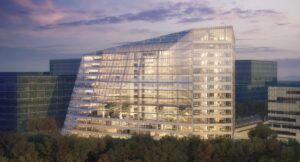As work evolves, it’s crucial to understand the new paradigms shaping our workplaces. Welcome back to our Unworking Weekly mini-series, inspired by new book “Unworking: The Reinvention of the Modern Office” by Philip Ross & Jeremy Myerson.
Over the past seven weeks, we have explored the themes of each chapter, offering insights into the book’s vision for the future of work and the workplace. Offices have been integral to society for the past century, influencing everything from city architecture to daily routines. However, the pandemic triggered a re-evaluation of the office’s role, promoting a shift away from outdated practices. As we enter the eighth week of our series, we explore Chapter 8, continuing our journey through the evolving landscape of work
This week’s blog focuses on Chapter 8: Technology, showcasing how it is not just a tool for digital innovation, but a fundamental reshaper of work environments. As we transition from analogue systems to digital solutions, the nature of work is becoming increasingly flexible, interconnected, and technology-driven.
In the context of work and the workplace, technology refers to the digital tools and systems that enhance how work is performed. This includes hardware like computers and mobile devices, as well as software for communication, collaboration, and productivity. More than just the tools themselves, technology is about integrating these innovations into work processes to create more efficient, flexible, and connected environments.
The Rise of the Digital Workplace
The digital workplace marks a significant departure from traditional office setups, embracing a more flexible, mobile, and wireless approach. This evolution is exemplified by the ability to work from virtually anywhere, thanks to cloud-based tools, mobile devices, and wireless connectivity. The concept of the digital workplace goes beyond just enabling remote work, it includes a holistic transformation in how work is organised, managed, and executed.
In this new paradigm, cloud computing plays a crucial role by providing access to essential software, data, and collaboration platforms from any location with internet connectivity. This has effectively eliminated the physical boundaries of the office, allowing employees to collaborate in real-time regardless of geographical location. Mobile technology further enhances this flexibility, enabling workers to remain connected and productive even while on the move. The integration of digital tools has also transformed the way organisations approach project management, communication, and even how we perform tasks, fostering a more agile and responsive work environment.
An example of this transformation can be seen in The Spaces in Amsterdam, a coworking environment that offers a seamless digital experience. The Spaces provides flexible workstations and a dedicated mobile app that enhances user interaction with the space, demonstrating how digital tools can be leveraged to create a work environment that caters to diverse and evolving needs. This modern approach to the workplace emphasises the growing importance of adaptability and accessibility in meeting the demands of the present and future workforce.

Smart Spaces and the Internet of Things (IoT)
The Internet of Things (IoT) is transforming physical spaces into smart environments where objects and systems communicate and adapt in real-time. IoT technology integrates various devices, sensors, and systems within a physical environment, enabling them to interact with each other and with users in a seamless way. This transformation not only enhances user comfort and convenience but also significantly improves operational efficiency and resource management.
Smart spaces are characterised by their ability to dynamically adjust environmental factors such as lighting, temperature, and occupancy based on real-time data collected by sensors. These environments can anticipate user needs, optimise energy usage, and create a more sustainable and responsive workplace.
A great example of this is The Edge in Amsterdam, exemplifying the trend of using IoT to manage building systems efficiently. The building’s infrastructure is embedded with sensors that monitor various parameters and adjust settings automatically, ensuring optimal conditions for both energy conservation and user comfort. Occupants can interact with their environment through digital interfaces, like smartphones or other devices, which allow them to control settings and access services on demand. This allows for a more personalised and engaging experience, transforming the way people interact with their spaces.

The Evolution of Communication and Collaboration
Communication and collaboration are at the heart of any workplace, and technology is radically transforming how teams interact, share information, and work together. The development of digital platforms specifically designed for improved collaboration and communication has revolutionised the process, making it easier for teams to collaborate in real-time, regardless of their physical location.
These platforms, such as Microsoft teams, Zoom, and Slack, offer a range of tools that facilitate not only communication but also document sharing, project management, and virtual meetings. These enable synchronous (real-time) and asynchronous (time-delayed) interactions, providing flexibility to accommodate different working styles and time zones. As organisations increasingly adopt hybrid work models, where employees split their time between remote and in-office work, these tools have become vital in maintaining connectivity.

Artificial Intelligence in the Workplace
Artificial Intelligence (AI) is emerging as a transformative force in the modern workplace. From automating routine tasks to providing advanced analytics, AI enhances decision-making processes and operational efficiency. In project management, AI-driven tools can predict project risks and suggest optimal resource allocation. AI chatbots and virtual assistants streamline administrative tasks and customer service, freeing up valuable time for employees to focus on strategic activities. AI’s ability to analyse vast amounts of data helps organisations understand patterns and trends, leading to more informed decisions and improved business outcomes. As AI continues to evolve, its integration into the workplace will drive further innovation and efficiency.
This chapter of Unworking sheds light on the transformative role of technology in the workplace. As we move from analogue to digital systems, the landscape of work is evolving rapidly. The rise of the digital workplace, the integration of smart spaces through IoT, Artificial Intelligence, and the advancement of communication and collaboration tools illustrate the profound impact of technology.
To dive deeper into the impact of space on workplace design and discover more insights from Philip Ross and Jeremy Myerson’s Unworking, grab your copy from Amazon here.
